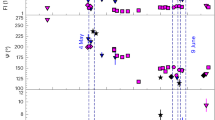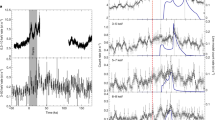Abstract
KEMP1,2 has reported that the power spectra of the Q and U stokes polarisation parameters, for the U band radiation from Cyg X – 1, show a ∼ 3σ peak at 39.26±0.10 d. The peak was found to represent a modulation in which Q and U vary, in phase, at 0.27% peak-to-peak total polarisation. While this was reported to be the strongest U band periodicity in the frequency range considered, it was not found in the B and V bands (ref. 3 and J. Kemp, personal communication). Further observations are necessary to set limits on this modulation for the various radiation bands. This letter suggests that such variable polarisation component may arise from those optical photons which, after being radiated by the disk, are Thomson scattered into our line of sight by the flared material at the outer parts of the disk and in the incoming flow4. Details will be published elsewhere5. Here we note that, with a favourable ratio of electron scattering opacity to absorption opacity and with a scattering depth τes ∼ 1, such scattering can polarise the photons to a high degree (∼20%); we also note, that the in-phase variability of Q and U can come about if the azimuthal structure of the scattering region does not have a 39.2d variation (for example, if the disk is always axially symmetrical), while the r,z structure does have sufficient variability to change the amount of scattered photons relative to the total flux and hence to produce a variation in total polarisation.
Similar content being viewed by others
References
Kemp, J. C. IAU Circ. no. 3060 (1977).
Kemp, J. C., Herman, L. C., Rudy, R. J. & Barbour, M. S. Nature 270, 227–228 (1977).
Kemp, J. C., Southwick, R. G. & Rudy, R. J. Astrophys. J. 210, 239–249 (1976).
Rees, M. J. Mon. not R. astr. Soc. 171, 457–465 (1975).
Milgrom, M. & Shaham, J. Astr. Astrophys. (to be submitted).
Mazeh, T. & Shaham, J. Astrophys. J. Lett. 213, L17–L20 (1977).
Lubow, S. H. & Shu, F. H. Astrophys. J. Lett. 207, L53–L55 (1976).
Hatchett, S., Buff, J. & McCray, R. Astrophys. J. 206, 847–860 (1976).
Heise, J. et al. Nature 256, 107–108 (1975).
Cunningham, C. Astrophys. J. 208, 534–549 (1976).
Milgrom, M. Astr. Astrophys. 50, 273–277 (1976).
van Paradijs, J. & Zuiderwijk, E. Univ. Amsterdam preprint (1977).
Lightman, A. P. & Shapiro, S. L. Astrophys. J. 203, 701–703 (1976).
Novick, R. 6th Texas Symp. Relativistic Astrophys. (Boston, 1976).
Ichimaru, S. Astrophys. J. (in the press).
Author information
Authors and Affiliations
Rights and permissions
About this article
Cite this article
MILGROM, M., SHAHAM, J. Possible 39-d polarisation period in Cyg X – 1. Nature 270, 228–229 (1977). https://doi.org/10.1038/270228a0
Received:
Accepted:
Issue Date:
DOI: https://doi.org/10.1038/270228a0
- Springer Nature Limited
This article is cited by
-
SS433—a massive black hole?
Nature (1979)
-
Eine neue Periode im R�ntgendoppelstern Cyg X-1?
Naturwissenschaften (1978)
-
The 39-d period in Cyg X – 1
Nature (1977)





